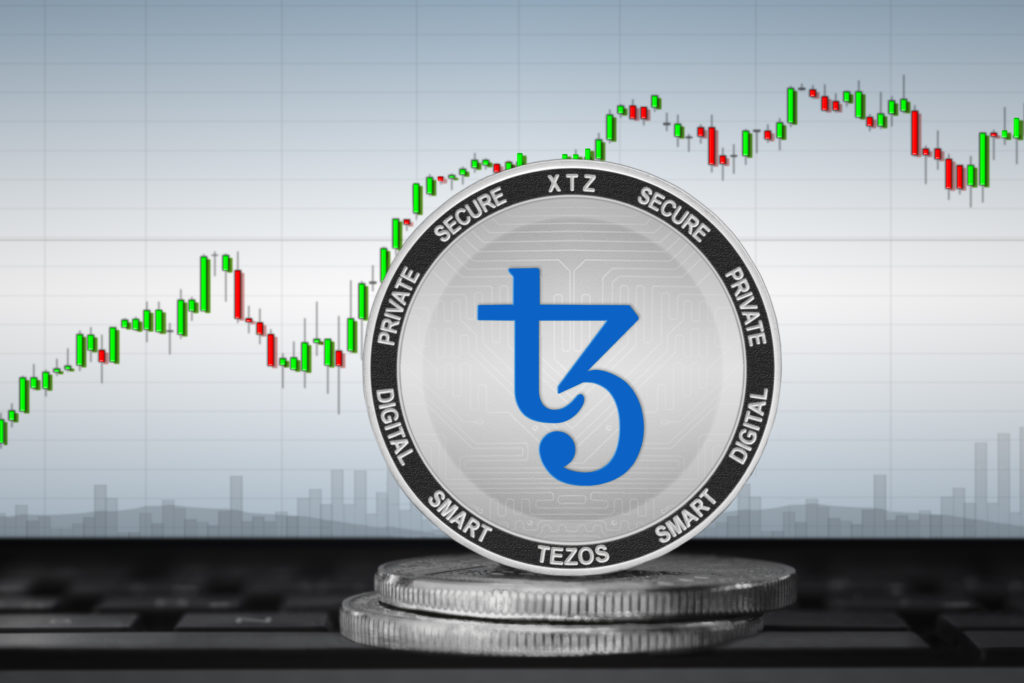Table of Contents
Introduction to the Tezos Blockchain
Designed in 2014 but going live in 2018, Tezos is a blockchain made to support and process smart contracts, describing itself as a self-amending crypto ledger. Initially developed by Arthur Breitman and his wife Kathleen, the project went through various hardships due to disagreements between them and Johann Gevers, president of the Tezos Foundation. The Foundation oversees the grants, marketing, strategic collaborations, and other promotions related to the Tezos ecosystem. The company was able to raise $232 million in July 2017 through Initial Coin Offering (ICO), which allows teams to raise funds for projects.

Key Takeaways
- The Tezos blockchain describes itself as a self-amending crypto ledger that uses a Proof of Stake system variation.
- Its smart contracts are written with the Michelson and OCaml programming languages, and its cryptocurrency is XTZ.
- Token holders can delegate their accounts to validators or delegation services (bakers), who will be in charge of baking and endorsing the blocks in their stead.
- Becoming a delegate requires 8000 Tezos
- The token holders do not need to transfer ownership of their tokens when delegating their validation rights.
How Tezos works
Similar to other blockchains, Tezos is a platform for developing and running dApps (decentralized applications) and exchanging assets. Here smart contracts are written using the Michelson and OCaml programming languages, and transactions are performed using the Tezos cryptocurrency (XTZ). The usage of formal verification in Tezos smart contracts allows those to be mathematically validated, dependable, and safe.
Tezos’ Proof of Stake system is a mixture of several ideas, making it somewhat similar to Delegated Proof of Stake and Liquid Proof of Stake. The blocks are mined by random stakeholders (miners) and contain several signatures from random stakeholders (the signers) of the previous block. Both mining and signing are rewarded but require a one-cycle (2048 blocks) safety deposit which will be forfeited if double mining/signing occurs. A random seed is created at the start of each cycle, using numbers that block miners selected and committed to in the second to last cycle and disclosed in the previous one. Then a “follow the coin” strategy is used with the random seed to distribute mining and signing rights to a particular address for the next cycle.
What is Tezos Baking?

Baking refers to the process of “creating” new blocks. To become a delegate and run the network by baking and endorsing (“agreeing” on a baker’s block), a participant needs to hold over 8000 Tezos. Also, if a participant does not meet the required amount or does not want to set up the hardware on their own, they can give such tasks to someone else. Token holders can delegate their accounts to validators (bakers), who will secure the network instead of them. The validator’s fee will be deducted when the users earn the generated rewards. Delegation in this context is essentially voting for a baker and showing that the stakeholders trust them. The amount of money a baker makes depends on the number of transactions they validate (the higher, the better). They distribute the acquired rewards to everyone that delegated their tokens to them, which is how stakeholders earn interest.
Earn Money by Staking Tezos (XTZ)
The stakeholders can earn a passive income by engaging in the Tezos network using delegations while staking. Tezos staking is beneficial because:
- The token holders do not need to transfer ownership of their tokens when delegating their validation rights to other token holders (validators).
- Thanks to its usage of self-amendment, Tezos can upgrade its network without the need to fork, allowing it to adapt to the regulatory and technological landscape quickly.
- Also, as mentioned in our other articles, the usage of a PoS system allows it to be more eco-friendly.
Staking Tezos: Steps Made Easy
If you want to start staking on EGG.fi, you can visit our “Staking” page through the button below. Once you are on the page, you can see which coins are available to be staked by selecting the cryptocurrency and clicking on the “Stake” button. We are currently in the process of adding Tezos staking. After you click the button, you will see a window where you can write the amount of tokens you wish to stake and see the rewards you will gain at the end of the locking period.
After clicking “Stake” once more, you will receive two pop-ups apart from each other. Although the waiting time may seem long, please do not leave or refresh the page; otherwise, you would need to start over. Once the “Transaction Submitted” message is displayed, your staking is complete.
Tezos Delegation Services: What Are They?
Delegating your baking rights is the safest and most convenient way to participate in the baking process. The stakeholders only need to send their baking rights to a delegations service, meaning the tokens will stay in the stakeholder’s wallet. Most services allow users to move their delegated coins whenever they want and usually do not impose lock-up periods. To choose the right delegation service for yourself, it is necessary to take into account the following three aspects:
Trust
Since you are delegating your baking rights to them, this means that the rewards will be sent to the baker (in this case, the delegation service). The baking reward (minus the applied fee) will then be sent to you by the provider. So, trust is essential.
Costs
All delegation services take a portion of the rewards for their services. The basic rule is that it should be about 10%. Be attentive, as the best offers are not always the best ones for you.
Overdelegation
Usually, a service will only accept a certain amount of Tezos tokens. So, if the stakeholder delegates too many, the service (and consequently the stakeholder) will be unable to secure rewards for tokens that exceed said limit.
Dictionary
Initial Coin Offering (ICO) – teams can generate blockchain-based tokens which will be sold to early supporters
Gas – the cost needed to perform transactions on the Tezos network
Delegating – in this context, it refers to entrusting your baking rights to another baker or delegation service
Baking – creating new blocks (can be another word for staking)
Forking – a split that happens when a change is made to the blockchain’s protocol or basic rules.
Final Thoughts
To sum up, Tezos is a self-amending crypto ledger, working on the POS system, and allowing users to transfer ownership of their tokens when delegating their validation rights. Tezos cryptocurrency name is XTZ and its smart contracts are written with the Michelson and OCaml programming languages. Staking or baking Tezos on EGG is easy and fast.
Disclaimer: The opinion expressed here is not investment advice – it is provided for informational purposes only. It does not necessarily reflect the opinion of EGG Finance. Every investment and all trading involves risk, so you should always perform your own research prior to making decisions. We do not recommend investing money you cannot afford to lose.
 English
English Français
Français Español
Español Bahasa Indonesia
Bahasa Indonesia 中文 (中国)
中文 (中国) Русский
Русский Português
Português Deutsch
Deutsch

